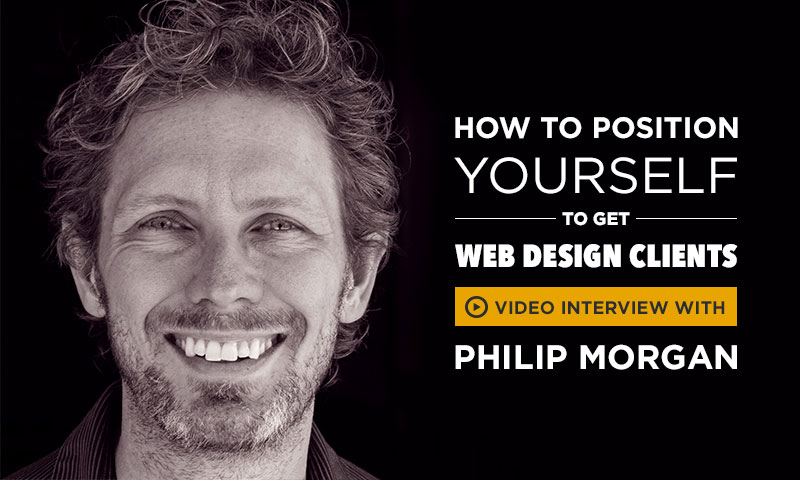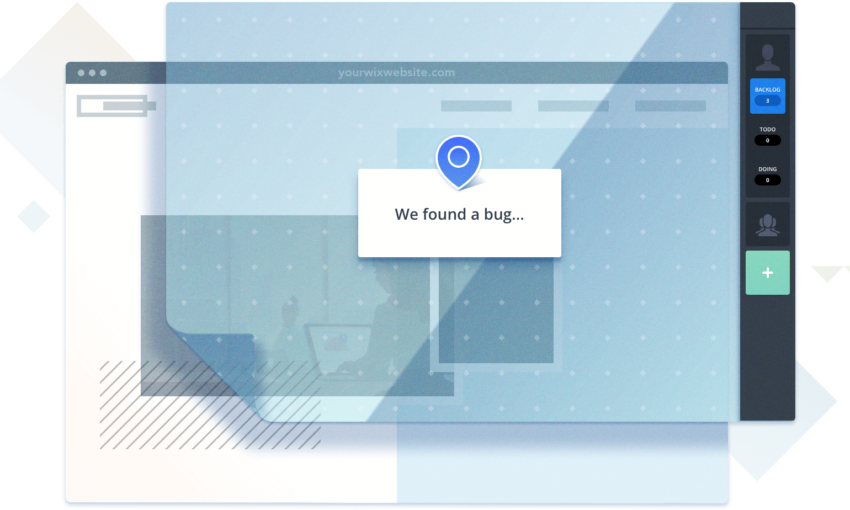We all have had bad clients, but who’s really responsible for that? Remember that every client is a human, who wants to be heard, appreciated, taken care of. Give and you shall receive.
“Businesses have no emotion. People do.”
I want to show you one simple and doable practice that will revolutionize the way you do client relationship management (CRM).
Table of Contents:
- Client Relationships
- 10 Things You Can Do to Get Your Clients on a Retainer
- How to Position Yourself to Get More Web Design Clients
- 10 Reasons Why You’re Not Getting Enough Clients
- Client Handling:Finding your Client’s Pain Points
- How Do You Convince Clients to Pay Higher Prices
- 4 Step Formula On How to Really Get Web Design Clients
- What Is And How To Do Web Design After Sales Service
The Freelance Designer Toolbox
Unlimited Downloads: 500,000+ Web Templates, Icon Sets, Themes & Design Assets
All starting at only $16.50 per month
Client Relationships
There is one key practice that highly successful service providers do which sets them apart from all the competition.
What’s that one simple way you can improve client relationships, and can you make your work with them enjoyable?
You’re going to learn CRM the way Jobs did through this lesson. We’re going to talk about a few things:
- Ideas on client relationship management from people leading their industries
- The disappearance of B2B and C2C marketing, and how everything is becoming about H2H marketing (human to human marketing)
- How to earn your clients’ trust and preference through one simple practice
Gone are the days when work is strictly work. Client relationship management has become a personal thing.
Gyro.com shares about how technology has forced B2B marketers to become more individualized in the approach by hitting the individual. As Bryan Kramer, CEO of PureMatter, places it well in his article for Social Media Today, “Businesses have no emotion. People do.”
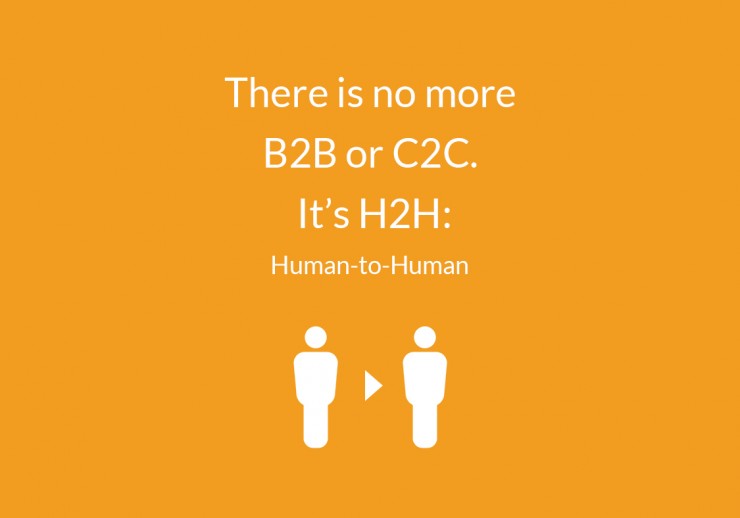
Business has to be more relational and less rudimentary. To become better in providing design services, we need to act more humanely. It’s one thing that separates the design industry from other industries.
It’s nothing far from what designers foundationally do. Conceptual professionals – designers, marketers, bloggers, etc.- are in the business of managing the perceptions and feelings of others. These are the professionals in making things human. Sadly, many creatives miss out on being human to their clients.
Salah Elkasef, introduces in his LinkedIn article, “H2H Marketing Reduces the Need for B2B and C2C Segmentation”, the concept of human to human marketing. He says,
“While it is true that businesses do not have emotions, the people that are making the purchasing decision do.”
Customer empathy has become necessary and vital in the way freelancers interact and market to potential clients and maintaining client relationships.
Elkasef also notes the disappearance of a B2B and C2C segmentation. B2B transactions are no longer supposed to be ‘corporate’ and ‘heartless’ in nature.
It’s true that many large agencies and a majority of freelancers still remain to be lifeless in their approach. However, this approach is no longer what dominates the market. It is the personal approach that stands out.
Many large media companies such as Vaynermedia now approach client relationship management as a human thing, no longer as a blind, lifeless practice. Client trust and preference are the key. Gary Vaynerchuk, CEO of Vaynermedia, once wrote that empathy is one skill that many people should learn, empathy in the way they deal with clients and with personnel.
Trust and preference build not only for a large quantity of clients, but also high quality relationship with each client. Marketing Metrics notes that the probability of getting business from a new prospect is 5-20% whereas getting business from an existing client is 60-70%. In the long run, depth matters most. Trust and preference brings higher returns at lower costs and effort.

What is most surprising is that majority of people are human only in their execution, and not in the way they do business.
A large number creatives and designers practice their human voices in the way they execute content marketing, design, writing, promotions and user experience and then treat their clients as issues, not people.
Kristin Smaby in her article “Being Human Is Good Business” points out three strong points about how to treat customers:
- A customer is not an issue or a channel.
- A customer uses channels to communicate issues.
- A customer is a human being.
This is greatly influenced by the traditional notion of ‘business being non-personal’ and seeing it unfit to be friends with business partners or clients. It’s surprising how much your competition does not see the need, or- even worse- treat as a taboo the idea of being friends with clients.
So here’s the burning question for everyone:
“Why do most freelancers perform SEO, design and improve user experience in a human way, and do client relationship management in a non-human way?”
The compelling case? It’s this simple: You can be friends with your clients.
Robert W. Dempsey puts it well when he asks the question– “What fear drives us to believe that we cannot be 100% ourselves with our customers, and that we must put up a facade in order to attract people to our businesses?”
Human relationship simplifies everything in client relationship management because it injects the trust factor. And, boy,trust a big deal in the industry.
The key to long term engagements with clients is the level of trust that you and your client share.
Trust and preference come in a package called relationship. To build trust, we cannot be disconnected with our clients- both existing and potential. And in a relationship, everything counts.
From the big things, such as ROI, better visual branding, delivering on time, down to the small things, clients will trust designers who hit all areas. Some of the small things clients appreciate include placing captions on wireframes, personally liking the client’s social media posts, and even greeting them on holidays. Sadly, so many designers miss the small things.
Yes! Greeting clients on holidays. It’s a small practice, but it is one that will revolutionize the way you handle relationships with clients. It has increased the level of trust clients have for me. Ever since I started greeting clients on holidays, birthdays, name days, most, if not all of clients have stayed longer for services.
Here’s an example of an email I sent out to one of my longest and biggest client, Zap.com.ph, as a Christmas greeting last year.
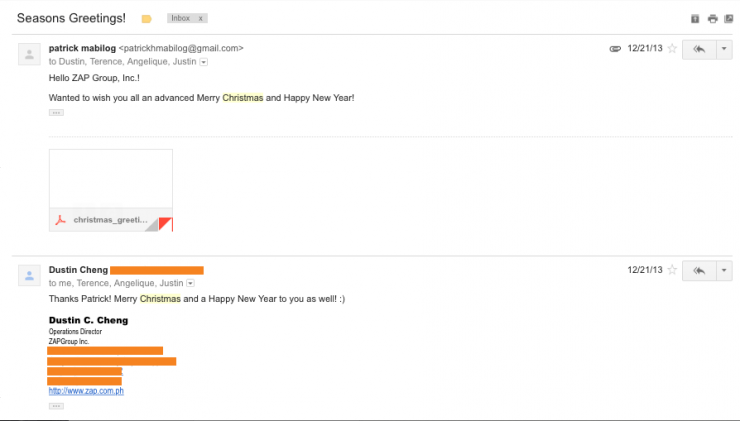
The Operations Director, Dustin Cheng, has now become more than a client. I have established with him a human-to-human relationship and not simply a business-to-business one. Zap has been a client for more than two years now. Aside from that, he has also referred countless other people to me for work!
I believe that sending out greetings is an effective, simple and sustainable practice for client relationship management. This is so for two reasons:
- It helps designers stay relevant. Greeting our clients communicates connection and relevance, that we are not just machines that cough-up PSDs and codes. We are people who value our clients.
- It makes the client feel human. When they feel human, they start acting humanely. They become more forgiving when you make mistakes, more generous when you inform them of increases in rates, when you screw up a scheduled meeting with them and so on.
1WD’s challenge is to have everyone apply this simple practice during the holidays. 1stWebDesigner is giving out a free Christmas card (in various formats, download zip file) for all you designers to download and personalize for your clients. Be as personal as you can with your messages.

Here’s an example of what the Christmas Card template 1stWebDesigner is giving out looks like. It comes in various preset colours, and there are five pre-made quotes as well that you can choose from.

The application is simple but not easy. Imagine having to break the status quo. Your client will find it weird. Your partners will find it weird. Even you will find it weird at first! But once you get a hang of it, it becomes life-changing.
You’ll be surprised at how much a simple greeting can do for your career, and client relationship management problems. Your CRM problems will decrease by half!
Human relationships are the key to long-term and successful partnerships with your client. If you get that right, you’ll be an industry leader in no time. Yes it’s important to be great at delivering, but personal relations will trump the business side anytime of the day.
Enjoy everyone!
In case you missed it, click here for the free christmas card template. Tell us what you think of them by putting your comments below!
Now lets talk about how to get your clients on a retainer. Shall we? Alright!
10 Things You Can Do to Get Your Clients on a Retainer
Most web professionals would agree that getting short term projects that don’t last anywhere longer than four months is leaving money on the table. With all the opportunities that comes along with web design projects, you can maximize on clients big time by learning the right practices and mindset.

Would you believe that just gaining two clients in one year can set you with work for at least three years?
I never thought it was possible when I started as a freelance web and graphic designer some seven years ago. I was always on job sites constantly searching for a job order for a logo design project or a web/UX/UI design project that could get me work for another week or so.
That was over five years ago, and I’ve only had three long-term clients since then, but with those three clients, I’ve officially let go of bidding wars, invoicing marathons, and referral fee frenzies. I’ve saved up to 40% of my time, and earned up to double what I used to get before.
What was my secret?
Here are ten practices that I started with and built and mastered on how to get and maintain long-term client relationships.
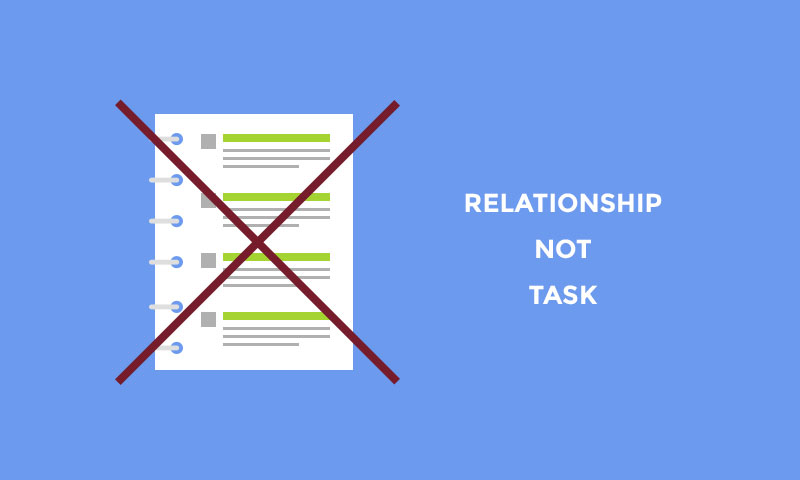
#1. Think relationship not task
The biggest thing for me was changing my mindset. I had to stop treating my clients as job orders, and see them as people who had expectations, dreams, and disappointments. I mostly work with tech start-ups without enough money to hire someone with a full time salary, but could pay a smaller amount for retainers.
At the course of conversations with these tech start-ups, I stopped seeing them as cash cows and saw them as people with a vision, and a hunger to get their idea off the ground. They were passionate and hopeful, and I was their key to seeing their dreams come to pass. When I realized that and started acting that way, they would open up to me more and when it came to end the project, they just wouldn’t let me go! Because I had become a part of their dream.

#2. Offer business solutions
Clients don’t want a website. They don’t want a logo. They don’t even want a UX/UI plan. They want a means to get their goals met, and you are there to offer them a chance to grow their business. If a health and fitness guru comes to you and asks you to make a website for them, offer them online presence to get their advocacy out. If a chef comes to you and asks for a logo for his restaurant, offer him a place in the hearts and minds of his customers that will make his brand trustworthy.
You are not just a designer. You are a consultant. If your clients fail to see that, 95% of the time it’s because you may have failed to communicate that well.

#3. Don’t get intimidated by big projects right away
The minute I heard the budget that first long-term client of mine had, I jumped off my seat both ecstatic and horrified. It was a big project, heck yeah! But it was also a big project (Oh crap). I wasn’t sure if I could handle building three projects (POS, Website and social media plan) all at once, but when we started discussing the possibility of cutting it up into phases, it seemed more doable.
Don’t just drop a big client just because they’re big. Get them because they’re big, and then delimit and plan.
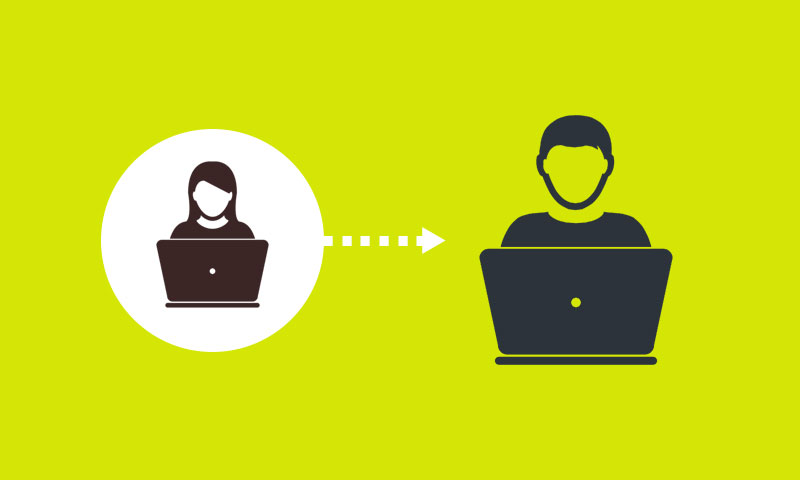
#4. Connect with and outsource other freelancers
Daniel Pink, in his book Free Agent Nation, talks about how the freelancing world has now become a web of creatives who can work together. If ever you do get a big project, and it’s just something you can’t do all on your own, connect with other creatives to help you out. I once got a big project to build a local legal resource online (much like Lexis Nexis), and they needed multiple creatives to go on the job.
So I connected and got help from an assistant designer and web developer. Those guys work with me until now on the same project, and I closed that deal two years ago. I now got the opportunity, not just to provide work for myself, but to provide work for two others as well. Plus, we launched that product straight away, and it’s now all over the country earning millions!

#5. Deliver results
Clients will trust you if you get them the results they need. When you work on a project either short-term or long-term, always think of how you can get more subscriptions, hits, traffic, leads, even profit for your client. If you cannot promise them that then they might as well hire someone else who can do that for them. However, if you do provide them that then you could be their ticket to building an empire out of their business, and of course they’ll love you and outsource all work to you.

#6. Offer content creation
Today, a website is next to nothing if it has no content. Content is the best form of virality and marketing today, especially in the online community. This does not just pose as a responsibility for you, but also as an opportunity to work with them long-term by helping provide content for their website. Get a few friends together to get some videos, articles, podcasts and whatever content up for your client, and charge for it. It’s just value for value.
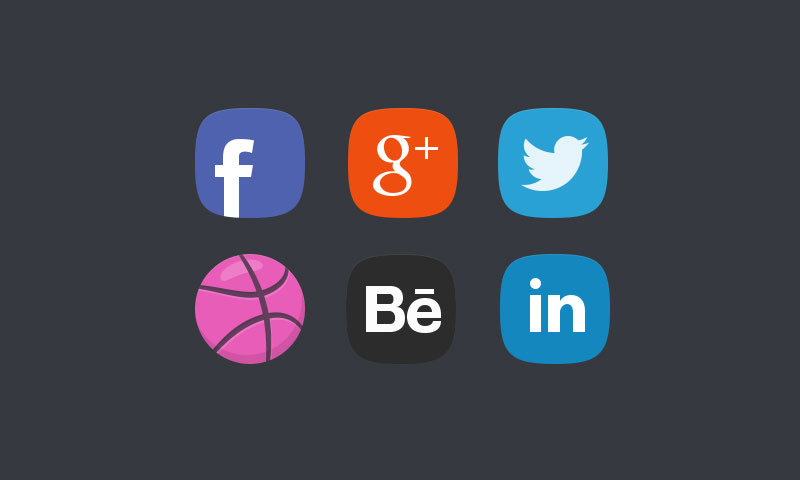
#7. Offer Social Media Management
Social Media is a whole new industry by itself, but one you can easily get into. Social Media advertising is a $24 Billion industry providing traffic for over 34% of businesses worldwide. It involves a lot of marketing and strategy, which you (once you adapt a business mindset) can really grow and thrive in. If you can sell your services online, you can definitely sell books for a publisher, or tacos for a restaurant franchise on social media.
Not offering social media management is you leaving money on the table, not just for you but for your client as well. When you make your clients your friends, you do everything in your power to make them successful. Help them with social media for a fee, and that will most likely happen.
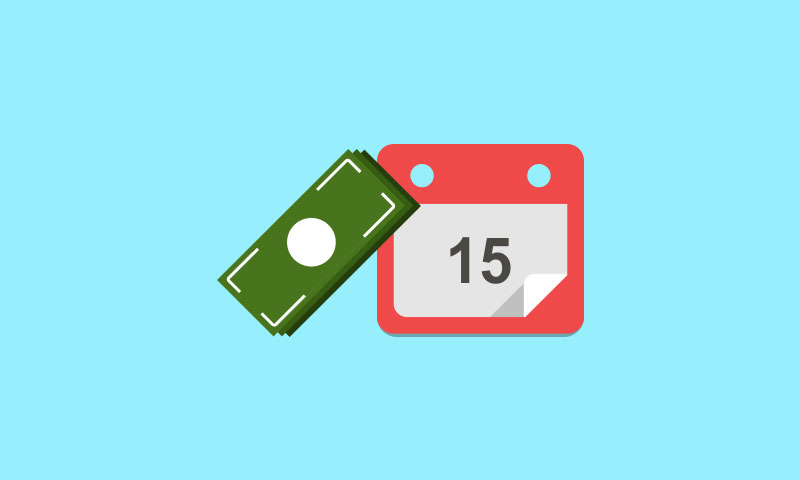
#8. Build integrity and value
I started off with hourly rates and learned the hard way that it was bad practice. It encouraged my clients to take advantage of the fact that if they needed to save money, they could cut me off the monthly budget because if I didn’t have to clock in hours, they didn’t have to pay me anything. Charging a retainer reminds your clients to maximize what they’re paying you to do and run to you when dollars aren’t coming in. Again that’s your job- provide solutions for your client to bring in traffic, subscriptions, leads and sales through that website they paid a lot of money to you to make.
Charging a fixed retainer also puts an expectation on you. A retainer is a challenge to stand up for your integrity. You can’t just bill a monthly fee and hide away in some wifi-less cave until the next bill. You have to deliver on your promise to give results. But also be aware that a retainer is not an excuse for your client to call you at any time of the day to have you work 20 hours straight on some email optin idea for their site.
They wouldn’t expect that from an in-house employee, and they shouldn’t expect the same from you.

#9. Bring your clients out to coffee
I’ve always seen it as a good practice to meet up with clients to just chat. I know bringing them out to coffee isn’t always a feasible thing especially when you get remote clients. But for those that you can meet up, you should meet up with them. Once a year, I fly out to Manila so I can have a coffee meeting with two of my clients just to discuss dreams and goals for their business. I always walk out of that meeting with an agenda and three-month plan for some new campaign or project.

#10. Greet them on special occasions
Again, I can’t stress this enough – your client is a person, not a bank roll. You have to be friends with your client on days apart from billing day. They will trust you more for it, and they will value you more for it. It’s not butt kissing, it’s not politics. If you build relationship just for that, you’re missing the point. Business is about people coming together to come up with solutions for people. Plainly put, business is about people and relationships. Not money, not mergers, not acquisitions, not seed funding.
What about those difficult clients from hell that are the devil incarnate? I promise to write about them in the near future, but one thing I can assure you is that you can still be friends with them. Everyone needs friends.
Conclusion
Out of all ten practices, you can forget them all and not apply some. But this one thing you cannot forget if you want to stop leaving money on the table and start getting long-term clients. It’s all about relationship. Your client is someone who needs you, and you can build trust and results for him or her.
Also, if you want to learn three more awesome practices, you can go here to watch three fool proof practices from the master of web design business himself, James Richman.
Don’t leave money on the table. Build relationships and build trust, and your clients will hire you out for the long run.
If you never thought that psychology could play a vital role in getting your next client, think again. Lets look at tips how to work with the help of psychology.
How to Position Yourself to Get More Web Design Clients
What is the biggest need of a web designer or any business? Is it better design or marketing skills? These are important, but in order to be successful and profitable, you need clients for the long term.
So how do you do it?
Our guest for today, Philip Morgan, gives expert advice how to do that. Philip is the CEO of Philip Morgan Consulting, a firm that helps web agencies and development shops get more leads, and provides an effective content marketing plan. He is also the author of The Positioning Manual for Technical Firms, a guide to help you get better clients and higher rates.
In short, if there is someone who can give you great insights about getting web design clients, Philip is your go-to guy. And here are a few of those golden nuggets to help you succeed as a freelance web designer.
Position yourself specifically
Having a different skills gives you an advantage because you have different things to offer to your clients. On the other hand, it can also be a disadvantage because you can lose your focus and spread yourself thinly. Philip suggests that if, for example, you have 10 different skills, don’t try to market all of them. Instead, focus on one or up to three and market them. In short, being a jack-of-all-trades will do you more harm than good if you want to attract more clients.
Speak to one audience
Speaking to different kinds of audience is already scary enough, but speaking to an audience with different interests and wants is much scarier. You simply don’t know how you’re going to please each, and you don’t know how to meet each need. Therefore, it is very important to find you specific client in order to focus, specific experiences, and develop skills. It is even much better if you focus on a specific niche.
Provide solutions
Understanding your skills is good, but it is even much better to understand how your skills fit to the needs of your clients. If you don’t know how to do this, you will never be able to provide an effective solution. Aside from this, it will save you time because you will be able to find what type of clients complement with the skills and experiences you have.
Positioning yourself is a process
Getting in the position of success takes time. Although there are some exceptions, no one gets successful during the first time. Even global brands have to undergo the process step by step to get into where they are now. Getting this fact straight gives you the motivation to keep trying when things get tough. Skills can certainly take you places, but patience will keep you going.
Conclusion
It can be quite difficult to position yourself to get clients as a web designer, especially if you are just starting. However, even the most seasoned web designer has a hard time to effectively market himself or herself. This can change when you also change your perspective about yourself, your skills, and your clients.
Now Watch The Full Interview
If you want to hear more in-depth information about what Philip Morgan shared, you can watch the video:
More questions about positioning and getting clients? Leave your questions in the comment box below.
Learn how to get clients with Philip Morgan
You have learned a lot by now, but we have given you tips how to get more clients. We have not touched the reasons why you are not getting enough clients. That’s what’s all about in the next section.
10 Reasons Why You’re Not Getting Enough Clients
One of the advantages of being a freelance web design professional is you are free from the 9 to 5 grind aside from being your own boss. However, after being one for a certain period of time, you might be wondering why you can’t seem to get the breakthrough you’ve been expecting – that is getting enough quality clients.
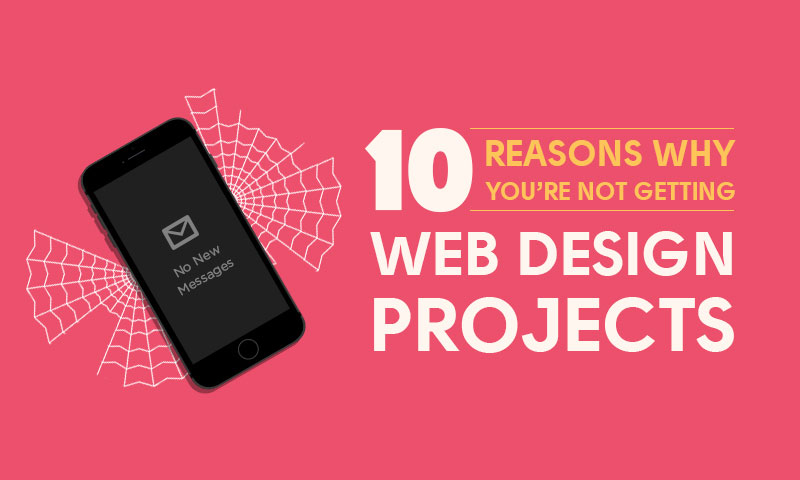
You have the skills, you know the tricks, you’ve done all the suggestions and advice you can get. Or have you?
This is one of the biggest struggles or dilemma any freelance web design professional has. So what is the real reason behind it? Let’s look at 10 common but often overlooked reasons why you’re not getting enough clients.
1. You are not networking.
When you have done a good job, your clients will turn into raving fans and become your spokespeople, right? There’s a certain percentage that this can happen. However, you should also consider the possibility that these satisfied clients might keep you to themselves. If this happens, what’s your Plan B?
If you don’t go out and market yourself either online or offline, how can other potential clients know about your existence? It also helps if you collaborate with other web design professionals – you don’t just gain clients, but you also gain new insights.
2. You are not consistent.
Any marketing campaign becomes successful when it is consistent. A good initial conversation with potential clients is meaningless if you don’t follow-up. Many opportunities are lost because professionals lack consistent follow up in their network. You can build consistency and therefore get enough clients by constantly creating positive conversations through email, social media, or offline.
3. You have nothing unique to offer to potential client.
In the world of freelancing, it has always been a race to the bottom – whoever offers the cheapest price wins the project. Why? Because everybody offers the same service and skills. Some can even do it faster than you do. Unless you stand out and have something unique to offer, you won’t turn your customers into raving fans and get the referrals you want.
4. You have nothing valuable to offer.
Something becomes valuable if it is desirable. You add value not just by offering something unique and excellent, but also by building relationships with your client. Everyone wants to know that somebody cares for them, especially when they least expect it. Your clients feel the same way – a small thank you note or a message asking them how they are makes a lot of difference.
5. You have a weak online presence.
It is a fact that when a potential client is looking for someone to design their website, they will ask for referrals. It doesn’t stop there, however. They will definitely check out each of those referrals’ profiles online for a background check. If you forgot to keep your online profile up-to-date, you might lose potential clients because of that.
6. You haven’t identified the specific client you want.
What kind of people are your dream clients? Does your website or profile has a message that deliberately convey that to the clients you want to attract, or are you still trying to be the jack-of-all-trades? The message on your profile or your website is a powerful tool to educate people about the type of clients you are looking for.
7. You are looking in the wrong places.
Networking is a good way to build your influence. However, if you are looking in the wrong places, you are also wasting your time. It means that instead of networking at general-type events, it pays more to network at events within the web design industry in order to find the right clients.
8. You have stopped upgrading yourself.
You are only as good as the last project you had. New technologies, tools, and strategies are being developed regularly. If you don’t take the time to keep yourself in step with these new technologies, trends and tools, you are driving yourself to extinction. Take time to learn and upgrade yourself, so you can add more value to yourself.
Might it be suggested to start off by investing into this ebook “Never Run Out of Projects Starting Today”. Pardon the shameless plug, but it’s guaranteed that this will help you upgrade those business and technical skills.
This book includes ten in-depth discussions and examples on the following topics.
1. Getting Steady, longterm projects
2. Placing up a Portfolio that Sells
3. How to Price Yourself
4. Connecting on Social Media
5. Advertising on Job Search Sites
6. Where to Get Clients Offline
7. Where to Get Clients Online
8. Creating Your Design Proposal
9. Creating a Client-Designer Contract
10. Client Management and Organization
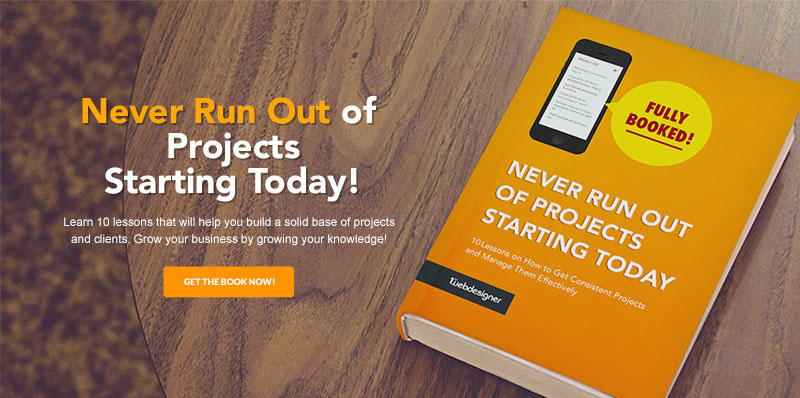
9. You are using the wrong marketing tactics.
Are the techniques and strategies to reach potential clients the most effective ones available to you? Are they the most appropriate for your target market? Do they match the skills and expertise you have? Use these questions to assess your techniques and strategies. If they do not work, it’s time to change them.
10. You appear desperate.
You need clients, but you don’t have to show how desperate you are to have one. Potential clients can sense if you are overly desperate about getting the project. Desperation can either attract the wrong clients who will abuse that desperation, or drive them away because of distrust why you have no clients. Instead be confident and be natural when talking to potential clients. Show them your expertise confidently.
Sadly, That’s Not All of It
And it cannot be stressed that a list of ten things cannot help you get more clients overnight. It takes constant practice, sacrifice and investment to build a steady flow of clientelle. You can learn much more through building your knowledge, and really putting money where value is provided.
Yes, the ebook, “Never Run Out of Projects” was mentioned, but if you’re not convinced that that is value enough, maybe you would also like to check out the video course version of the book.
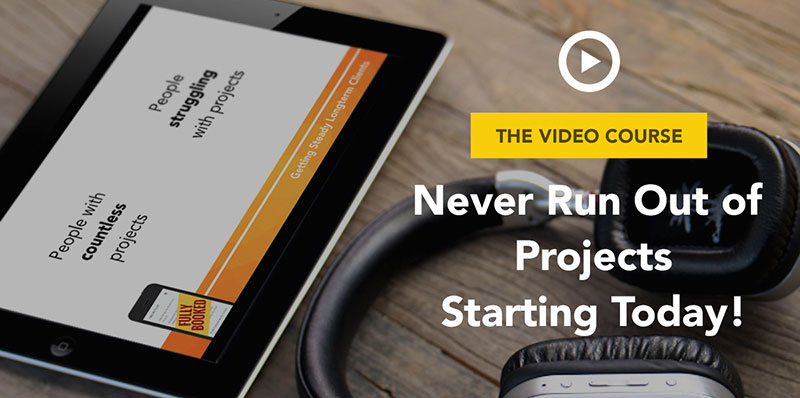
Getting clients and keep them for the long term is difficult. What you say and do not say will greatly affect how you attract potential clients. However, once you know what’s stopping you, you can change strategies and fix mistakes you have been making.
In the next section we will look at how to handle clients and find what they are after.
Client Handling:Finding your Client’s Pain Points

In my years of dealing with a variety of different clients, I have noticed one curious trend. It is amazing how many other Web designers have left a bad taste in people’s mouths from previous experiences they’ve had. I think this boils down to two things: lack of experience and lack of awareness.
I want to cover the second point today. As a Web designer/developer, you have an amazing opportunity to shape your clients’ perceptions of what the Internet and online technology can do for them and their business.
Your actions will largely determine how successful your existing clients are and who your next client will be. How you go about this can take a variety of forms, but as many a marketing expert will tell you, one very effective way of growing your business is identify your customers’ pain points.
Recognizing pain

Photo by Tomasz Kobosz
Every customer is going to have one or more frustrations related to their business or their Web site. You need to learn how to read between the lines and listen past the immediate requests of your client. The goal is to keep reinforcing the idea that you understand what they really need and can articulate it better than they can.
Many business owners are intimidated by technology. There’s an obvious pain point: “Help, I don’t understand how this stuff works!” Therefore, the more you can educate your client, translate computer/Internet jargon into plain everyday speech, and empower your client to learn more about good Web practices and the benefits of regular updates (news, product updates, blogging, social media, etc.), the more you will be seen as a vital business partner.
Learn to recognize pain points by asking the right questions and listening to the answers. You can ask about your client’s goals and vision. You can ask about who they want to target to grow their business. You can ask what motivates them and what doesn’t. For those with existing Web sites, you can ask what features they get requests for often, or which off-the-wall things they might wish they could do. The goal isn’t necessarily to implement their requests verbatim, but to get an idea of where to focus your invention and ingenuity.
Eliminating pain

Photo by Ali Farid
For example, suppose you’re working on a niche community site for a client, and they ask how you can allow members to embed videos on their profile page. You know the client doesn’t have the funds to pay for a video streaming solution like Brightcove, so you suggest simply allowing users to post videos from YouTube. They say “great, make it so” and agree to a bit more cash to pay for your implementation. Now you have three options at this point:
- Create a free-form HTML box and allow people to paste in YouTube’s code for embedding videos. Simple for you to implement but rather confusing for many users. Hardly a great experience and it only creates another pain point.
- Find a prefab JavaScript widget that can automatically suck in videos from a user’s YouTube account. A little bit better, but remember, your client wants community members to embed videos that are relevant to the topic of the site. Besides, you don’t want to blindly copy someone else’s UI. This is an experience that YOU are creating for your client and their audience.
- Develop a solution where a user can copy a YouTube video URL into a field and you’ll generate the embed code automatically. Make it better by allowing users to add and delete specific videos from their profile. And, while you’re at it, let users provide a username, then show a list of recent videos from their account and allow them to choose a video to embed. Top it off by adding support for the popular alternative video service Vimeo as well. You or a developer can program this by using the publicly available APIs that YouTube and Vimeo provide.
I chose the third option for a real project I worked on last year, and my client was thrilled with the outcome. Remember, their pain point was “how do I support videos on my site? I don’t want it to cost lots of money!” By creating a transparent, straightforward process whereby social media videos could be added and displayed in the context of the site’s personalized UI, I reinforced the idea that I understand needs, know how to solve problems, and make cool things that work right.
Don’t be afraid of pain

Photo by Jamie Brelsford
It’s easy to find articles circulating like “How to avoid bad clients” or “Freelance clients that suck”. While it’s true that some clients are more trouble than they’re worth, and it’s a good idea to keep an eye out for potential money/time drains, I think it’s wrong to have the attitude that clients are generally a bother who need to be contained.
Don’t be afraid of your clients’ pain. When they seem to be making unreasonable requests or are exasperating you with their endless questions or concerns, remember, YOU are the professional. You weren’t hired to be a hot-shot, you were hired to solve problems.
Find out what the client really needs. Dig a little deeper. Perhaps those endless requests to tweak a certain HTML form is stemming from them not really knowing what info is most important to capture. Take a step back and help them determine what the particular business need really requires, then implement the form accordingly.
Or maybe you find yourself going back and forth on the colors of the header for a site. Stop and think: did you talk to the client originally about what colors they like or don’t like? If your client hates sky blue, no amount of convincing on your part will make them love your sky blue background image. After all, if you think you should have the ultimate say on what looks good, then go join an art gallery. Fact is, you’re a designer for hire. Your client’s happiness is ultimately all that matters.
Become the Expert that Everyone Wants

Photo by Asif Akbar
Imagine a business owner you’ve worked with telling their friends: “you’ve got to talk to my Web designer — s/he is so easy to work with and always knows how to make things work better and fix problems that come up. I used to be confused by all this Web stuff, but s/he made it simple for me!”
A client will of course be happy with the good-looking design you create or the nifty feature you implement, but the truth is they’ll be most happy with your professionalism. Stay on track, ask lots of questions, go the extra mile, and eliminate their pain points. It may seem like a lot of effort to jump through every hoop that arises, but when you go above and beyond the call of duty, you cement your reputation as a can-do key player in the Web design business. In the end, it will definitely pay off!
What do you think? I’d love to hear your feedback below.
Thumbnail photo by Derek Kimball
Now lets see how to convince clients to pay higher rates.
How Do You Convince Clients to Pay Higher Prices
Welcome to another #EspressoMonday episode. This time, a new James Richman drinking espresso in a real espresso cup will answer your question.
This episode is short and sweet but, nonetheless, meaty. It answers the dilemma of a lot of web designers as well as other freelancers who struggle with pricing. To give you a much needed boost this Monday, James has invited Brent Weaver of Ugurus to answer the question. So take a few minutes of your time to learn from Brent but don’t forget your espresso.
Here’s a very common scenario – You’ve been putting a lot of time and effort in building your clients’ websites that you feel that it’s time to increase your fees or rates. However, you are afraid that if you do, you will lose a client or worse, you can’t get any more clients. So how do you do it?
How do you convince your clients that you are more valuable than what they pay?
Swimming Against the Current
Swimming against the current can be exhausting and challenging. It takes extra effort and there’s also a price to pay.
Then why swim against the current? Because even dead fish go with current.
So if you don’t want to be counted as one of the dead fish or even just another fish in the ocean, you need to do something and that is to swim against the current.
You have to be aware of the fact, that the web design marketplace is a competitive and crowded one. Thus, you can’t simply be as good as the other designer around the corner. One of the first thing you need to do if you really want to put value in what you do is to stop thinking of yourself as a commodity. A commodity is something that you can easily find – very common, nothing special.When clients see that, they will not think of you as anyone different from the rest. They will think that you are like the rest who is easy to find on the Web and in other marketplaces, such as Elance.
Thinking of your service as a commodity is also the worst disservice you can do to yourself. Why? Because when you think of youself as this, you are sending out a message that your service can easily be exchanged for another provider of the same service who offers a lower price.
However, you are not a commodity. You just haven’t defined your value add-on yet. In order to put value on yourself and what you do, you need to be very strategic because this is where it all starts. In terms of being strategic, the first thing you need to do is to quantify the benefits you’re bringing to your clients’ businesses. In order to do this, you need to communicate what the ROI or Return of Investment is.
How do you do that?
First you need to clearly define what the “Return” is as well as what the “Investment” is. In order to define what “Return” is, you need to understand where your client is getting value from. What gives them the money? What increases your influence or your power to them?
You need to clearly define what kind of return do they need to do and how do they get it? Does it mean selling more stuff? Or do they have to find more customers to buy their stuff?
In web design, what is it that they are looking for – SEO, Analytics, design, CMS? You need to figure them out so that you will be able to get the high investment you want from your clients.
Another important thing to remember is that you Don’t need to Convince your clients about the value they’re getting in order for them to invest. Instead, you show them what the value is because when they see the positive return they will get, you don’t need to say anything but they will have the initiative to invest more.
Conclusion
There’s nothing wrong in being a commodity. If you are satisfied in just paying your bills and getting paid on time, then go for it. However, if you are looking for more value and for higher income, you should not be afraid of discussing ROIs. Instead, you should start positioning yourself where you can communicate what your ROI is to your clients.
Moreover, you have to know where your value comes from and the real value of what you’re providing. That is where the real value equation comes from. That’e where your real value lies.
Now lets take a look at how to get clients, where to look for, and should you be involved in biding wars.
4 Step Formula On How to Really Get Web Design Clients
Clients and Coffee
This a special #EspressoMonday Episode because instead of three, we are going in-depth with only one question – how to get more clients – which is often the concern of every freelance designer/developer, who runs his web design business. If you are wondering how to do it and where to look for, all you need to do is a cup of coffee and a few minutes of your time.
I have observed that projects, especially on Elance and Freelancer, have become a bidding war where 99% of projects goes to those who bid the lowest. On the other hand, big agencies are getting big projects worth $5,000-$10,000, even $50,000 – $100,000-worth projects. Where do I look for these? What other sources would you suggest?
Is Web Design Becoming All About Bidding Wars – Cheap Web Design?
It is a fact that job search sites, like Elance, Freelancer, and PeopleperHour, are built for bidding wars and the clients that go there are looking for cheap web design providers because they also want to save as much money as they can. As a freelance web designer, it might be the most logical step to do and the best place to look for clients quickly. However, you should not even be there in the first place. You should never be involved in that kind of race, which is a race for the bottom because YOU are WORTH more than what is offered in these sites.
There are alternative quality job search sites appearing like AwesomeWeb (our own creation) and Codeable.io, which focuses on finding quality designers and attracting higher level clients, who look for quality work.
For web design agencies that have the power to charge $25,000+ for a certain project are agencies that are full of web design experts, coding professionals with various skills, and years of experience. Clients, on the other hand, are interested how many people will actually work in a project. They want to know the different kinds of skills and expertise that would go into it and they are willing to pay more.
As an individual freelancer web designer, however, you should hit the middle ground which is between $5,000 and $10,000 per project. In fact, this should be how much you as a web designer should charge per project. How do you do this or how do you even begin? Here’s a three-step formula how to start looking for more higher paying clients and charging what you are worth for.
1. You have to be READY to be worth the money you are asking for.
The keyword is READY. With ready, we are not just talking about your skills but it refers to everything about you. You should know how much you are really worth. However, it does not stop there – the physical things should match the mindset you have. The physical things should also manifest that you are ready to ask your money’s worth. It means that your website should reflect the skills you have and they type of expertise you offer.
In short, your website design should already show that. In addition, your website should also include your pricing so that they have an idea how much monetary reward you are expecting for providing your design services. Pricing also reflects that you already know how much you are worth and are confident about it.
2. Find out who makes the decisions and controls the budget.
Projects which range between $50,000 and $100,000 are usually by large companies who have a CMO or Chief Marketing Officer, who is responsible for the overall budget and strategy of the company. They are also in-charge of the advertising strategies and branding initiatives of the company. In short, they are the ones in charge who should be involved in the project as well as how much should be spent in that project. These are the people you should be in touch with. If it is not the CMO, know the person who is responsible for this in a company. Take the time to know them and talk to them.
After figuring out the person in-charge, the next step you need to find out is the place where they hang out. Where can you find these people? If you know where they are in the first place, you know who to talk to and all the more you will have higher chances to get noticed. In addition, part of knowing the places where these people hang out is to also know what their interests are – the websites they visit, the books or articles they read, the conferences they attend, and more.
3. Grab their attention – find the way to stand out from the crowd between other web designers.
There are thousands of web designers and developers out there – this is the reality that you should always remember. These web designers might have similar skills and talents as you or even much better than you. With this in mind, you simply cannot write a letter to a company saying “I am a web designer and I can build you a website,” because thousands of others can also do that and maybe at a much lower price than you.
Therefore, it is very important that you need to find your unique angle – something that will make you stand out among the others. It could be a particular technology you have or a certain expertise/specialization you offer. Standing out can also mean finding your niche and work for it to make things happen.
After you figure out your unique angle, you also need to find the right format to deliver this difference. For example, if the person-in-charge of the project you are eyeing visits websites, such as Forbes, INC., or Business Insider, you might want to do a guest post to these sites. You might not get paid for your contribution but they will have a massive return of investment to you because you will be able to showcase your skills and expertise through these blog posts.
Another format can be podcast interviews. Find out the kind of podcasts in the industry that would want to feature you. You can also shoot a video, like this #EspressoMonday videos, and address a certain issue that would show what you got.
And….a BONUS fourth step that is very important ….
4. Repetitive appearance matters instead of a single effort.
Studies have shown that a person does not decide after seeing the product once. Instead, a buying decision is always made after the consumer has been exposed to a repetitive campaign of a certain product. This is the trick big companies use to amass huge sales.
That is why companies spend a big amount of their time, money, and effort in marketing campaigns. That is why you get a barrage of advertisements and commercials of products in every media platform every minute, everywhere you go. These companies are creating a want and a desire in you to actually like a product even though you don’t initially like it.
You can use this same trick. Which means doing one guest post is not enough. Instead, you need to widen your exposure by using different formats and platforms to show your expertise. One good example of this is Derek Halpern of Social Triggers. Before he or even his blog became famous, he approached companies and provided solutions for free. All he asked was to record a Screencast of him pointing out the problems and offering solutions. Then, he put up these videos on YouTube until he got noticed.
So invest your time to show off your expertise repetitively, even for free. Take your time to expose your skills and the return of investment will be huge.
To have a better relationships with your clients, there is one important thing called after sale services. That’s what were are going to talk about in the next section.
What Is And How To Do Web Design After Sales Service
How can a web design after sales service potentially let you increase your monthly revenue?
Welcome to another #EspressoMonday episode and this time, we will do something different – espresso shot in a wineglass. Veering away from the traditional shot glass, it proves that good coffee always tastes good in any way.
The same goes true with web design – a great website will prove itself in any way. The problem, however, is how do you tell this to your client. So with your espresso in any type of container you want, let’s talk all about after sales service that will help boost your income.
Artists and creatives have long since held to the romantic notion that it’s okay to be hungry as long as you are able to express your passion for your art. Since web designers are also artists, there are still a lot who hold on to this notion. However, this belief is as outdated as the latest trend during the Middle Ages because now, artists, web design professionals in particular, can earn a monthly revenue while doing their passion with the right tools and knowledge.
Everything Begins in the Mind
Rene Descartes was never more right when he declared his famous philosophical thought, “I believe; therefore, I am.” The short statement is a simple yet powerful confirmation of the power of the mind and how it can shape your future, much more your career as a web design professional. That is because everything that manifests physically begins with a single thought in your mind.
But what does it have to do with after sales service?
A lot!
Because if you want to boost your after sales service or utilize it to its fullest potential, you need to pick your clients’ minds first. This is how marketers and advertisers condition us to rush and buy the latest product or use the newest service in the market.
Everything is calculated – from the fonts to the colors to the words. All of these elements are used to condition the mind to act in favor of the product or service. It sounds like a plot to a scary science fiction film where we are brought into submission without a hint. There’s some truth to it because how many times have you bought something because you were greatly affected or influenced by the ad. The good news, however, is you can utilize the same method when you do your after sales service.
All you have to do is focus on these four psychological elements:
- Buyer’s Instinct
- Sense of Urgency
- Sense of Danger, and
- Survival Instinct
How Does It Play in Your After Sales Service Pitch?
One of the best and most lucrative areas to focus on is security.
Let’s say you are building a website for your client and trying to upsell on a monthly service. So you offer your client to look after the website’s security and make sure that it is not hacked – that it is always safe and secure. While the threat of security is true, none of this will mean to your client if you just go out to him and give him a quote of your monthly fee for such service.
You have to always remember that clients think differently unless they have background knowledge about what you are talking about. What your client basically wants is for you to get the job done and do it well – end of story. If you want to convince them, you need to present to them a social proof from a credible source showing the dangers of breached security.
WordPress is a good example to start with since it it both popular and credible. WordPress has experienced how hackers wanted to penetrate the site’s security but WordPress is fighting back defending its security by releasing different kinds of patches.
Or you can also use an article about a famous website which has been hacked. Take the article and present it to your client. You can point out to them what happened and the same thing can also happen to them. You can paint them a picture about what happens to a website and how it will cost them more if they overlook such things. Tug their emotions by painting a clear picture of what could happen.
Once you are able to clearly present it to them, they will have a sense of danger as well as a sense of urgency. It is a given that when a person feels threatened, it will do everything in its power to build up is defenses in order to fortify himself. That’s where your sales pitch come in. You present them with a solution that would make them feel safe. Yes, the threat is real but there are also counter measures against it and that you are ready to help them build it.
After you’ve done a good job and you have satisfied your client, you have already tapped into their buyer’s instinct. So next time they need a similar service, you become their go-to person. Chances are, they will even recommend you to their colleagues.
At first next subject maybe won’t have much in common what we have talked until now, but you’ll see it can be the beginning of you relationship with your client.
This post may contain affiliate links. See our disclosure about affiliate links here.

